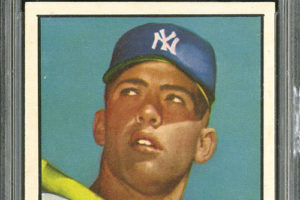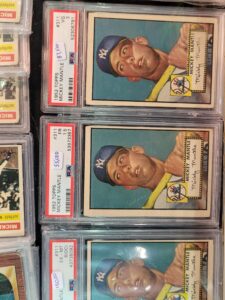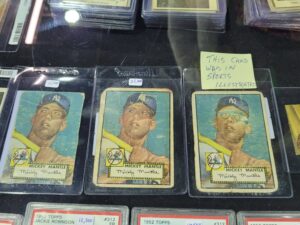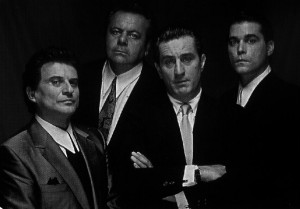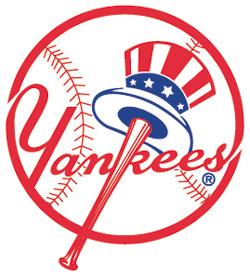The stars truly aligned here- the most essential modern era set, a first-ballot Hall of Famer subject, and a backstory that reads like a top-notch Hollywood script.
While there are numerous Mickey Mantle cards out there capturing the hearts and minds of collectors, the 1952 Topps Mickey Mantle #311 is extra special, and the scarcity is a big reason why. Even if it was not “organic” scarcity, how it happened is a story all within itself.
In the autumn of 1951, cartoonist-artist-writer Woody Gelman and Sy Berger, then a 28-year-old World War II veteran and the man who came to be regarded as “the father of modern baseball cards,” designed the 1952 Topps baseball card set.
Their drawing board was the kitchen table of Berger’s apartment on Alabama Avenue in the Broadway Junction section of Brooklyn.
The duo had found some initial success in 1951, with the first Topps set, but to match or surpass Bowman, the Brooklyn boys knew they had to go big or go home.
It would turn out they went a little too big (at least in terms of the print run), but the card design itself is stunning. Its boxy theme evokes the Bauhaus ideal of “less is more,” with form truly following function.
The ’52 Topps set was unlike anything the trading card industry had seen before, as it was massive in size and scope for the times. The low numbers, which debuted in spring, sold like hotcakes, but the tide turned when the high numbers premiered in late summer/early fall.
Mantle was the first card to appear in the higher numbered portion of the set, which had trouble selling due to its having to compete with football for attention.
The American sports fan constantly shifts their focus to the gridiron during the harvest season, and with that, interest in the high series and baseball cards plummeted. Returns started to pour in, and a severe inventory backlog developed in the Topps warehouse.
For years, Berger tried to counteract this problem by hawking these cards at carnivals for a penny apiece, and then it even went to ten cards for a penny. Honestly, he couldn’t give them away. Finally, by around 1959 or 1960, the lack of storage room in the warehouse meant that drastic action had to be taken.
“They were put in boxes,” he said to Tuff Stuff magazine’s Topps 50th anniversary issue in 2001.
“It took three garbage trucks. I would say 300-500 cases—all high series of 1952 Topps. I found a friend who had a garbage scow, and we loaded three trucks worth on the barge. I was out there with it a few miles out.”
Yes, it sounds like a scene from “Goodfellas” or “The Irishman,” but it’s true. Berger led a truck to barge outing from the Brooklyn warehouse to the East River and then into the Atlantic Ocean. Literal boatloads full of double-printed 1952 Topps high numbers (featuring Eddie Mathews and Jackie Robinson in addition to Mantle) met a watery grave.
It’s all such a very New York tough guy kind of story. It evokes dialogue from a mafia movie (“eh, I’m telling youse, that it fell off a truck, you know, so just fuggedaboutit.”) While these events power some of the mystique of this card, it’s also pretty sad at the same time.
All those lost hobby treasures, including thousands of copies of the most iconic sports card ever, met a saltwater demise.
It is estimated that less than 2,400 copies of this card still exist today. In 2004, Topps created a Sy Berger card, modeled of course, in the 1952 design.
Eric Norton, a grading expert with Beckett Media, conversed with Gold Card Auction about a week after a very subpar condition version of this card commanded five figures at auction.
“It didn’t even have a grade on it,” said Norton.
“It was just labeled as authentic; looked like it had been run through the wringer; it was beaten up. It had scotch tape on it, scratched, and creased, it was disgusting, and it sold for almost $11,000.
Yes, that’s how valuable this card is.
“There are some cards that defy the logic (of condition factoring into pricing), but there are not many, and that 52 Mantle is one of them,” Norton added.
The back of the card reads, “Mickey is heralded as Joe DiMaggio’s successor,” so even at the time, everyone knew he was going to be something special.
It was baseball’s all-time golden era, and he was the golden boy. You know the song: “Willie, Mickey and The Duke (Talking Baseball).”
His hero status, coupled with the time and space in which he achieved his accomplishments, have made him one of the foremost figures in the history of the hobby.
Both he and this Topps card/set came along at just the right time. And it’s astounding when you think about it today- something Berger tried to give away through toy companies in the 1950s, it now fetches hundreds of thousands, and sometimes even millions, of dollars these days.
The Mick is incredibly unique in that his fame occurred in an era when the press was often willing to look the other way or even help cover-up, up his excessive drinking and extramarital affairs. Mantle wasn’t exactly all that discreet about his alcoholism or his repeated adultery, though.
However, the reality of the very flawed human being has been submerged enough so that the mythical hero of #7 could live forever.
In his day, he was considered the ultimate man’s man, and while that term has evolved and taken on a different meaning over time, The Mick’s rep has held up nicely.
Paul M. Banks is the Founding Editor of The Sports Bank. He’s also the author of “Transatlantic Passage: How the English Premier League Redefined Soccer in America,” and “No, I Can’t Get You Free Tickets: Lessons Learned From a Life in the Sports Media Industry.”
He currently contributes to Ravens Wire, part of the USA Today SMG’s NFL Wire Network. His past bylines include the New York Daily News, Sports Illustrated, Chicago Tribune and the Washington Times. You can follow him on Twitter.
